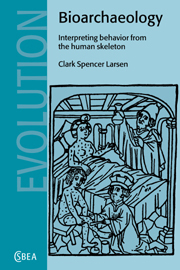Book contents
- Frontmatter
- Contents
- Acknowledgments
- 1 Introduction
- 2 Stress and deprivation during the years of growth and development and adulthood
- 3 Exposure to infectious pathogens
- 4 Injury and violent death
- 5 Activity patterns: 1. Articular and muscular modifications
- 6 Activity patterns: 2. Structural adaptation
- 7 Masticatory and nonmasticatory functions: craniofacial adaptation
- 8 Isotopic and elemental signatures of diet and nutrition
- 9 Historical dimensions of skeletal variation: tracing genetic relationships
- 10 Changes and challenges in bioarchaeology
- References
- General index
- Site index
4 - Injury and violent death
Published online by Cambridge University Press: 05 June 2012
- Frontmatter
- Contents
- Acknowledgments
- 1 Introduction
- 2 Stress and deprivation during the years of growth and development and adulthood
- 3 Exposure to infectious pathogens
- 4 Injury and violent death
- 5 Activity patterns: 1. Articular and muscular modifications
- 6 Activity patterns: 2. Structural adaptation
- 7 Masticatory and nonmasticatory functions: craniofacial adaptation
- 8 Isotopic and elemental signatures of diet and nutrition
- 9 Historical dimensions of skeletal variation: tracing genetic relationships
- 10 Changes and challenges in bioarchaeology
- References
- General index
- Site index
Summary
Introduction
Investigation of injury morbidity and mortality facilitates the assessment of environmental, cultural, and social influences on behavior. Many injuries are not identifiable in human skeletons, and accidental death is virtually invisible in the archaeological record except under special circumstances, such as building collapse or natural disasters (e.g., Cicchitti, 1993; Deiss, 1989; Palkovich, 1980; Sakellarakis & Sapouna-Sakellaraki, 1991). Nevertheless, osteological remains provide a highly useful index for assessing accident and violence in a wide variety of circumstances (Courville, 1962; Jimenez, 1994; Knowles, 1983; Manchester, 1983; Merbs, 1989a; Ortner & Putschar, 1985; Walker, 1997a, 1997b; Webb, 1995).
There is an abundance of skeletal injury data presented in the osteological literature. The sparseness of a population perspective in this literature, however, precludes the realization of the enormous potential that these kinds of data have for drawing inferences about human behavior and conflict situations in earlier societies (Burrell et al., 1986; Kennedy, 1994; Milner et al., 1991; Roberts, 1991; Walker, 1997b). In addition to this shortcoming, several problems encumber the study of injury in archaeological skeletal remains. Chief among them is the confusion that sometimes arises between skeletal damage originating from accidental or violent causes vs. damage having nothing to do with past human behavior. For example, damage to bone produced by shovels, trowels, and other equipment during archaeological excavation can produce marks on bones that mimic blade-induced cutmarks (Milner et al., 1994; Smith, 1997).
- Type
- Chapter
- Information
- BioarchaeologyInterpreting Behavior from the Human Skeleton, pp. 109 - 160Publisher: Cambridge University PressPrint publication year: 1997
- 2
- Cited by



